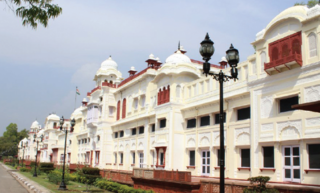
Patiala is a city in southeastern Punjab, northwestern India. It is the fourth largest city in the state and is the administrative capital of Patiala district. Patiala is located around the Qila Mubarak constructed by a chieftain Ala Singh, who founded the royal dynasty of Patiala State in 1763, and after whom the city is named.

The Walled City of Lahore, also known as the Old City, forms the historic core of the city of Lahore in Punjab, Pakistan. The city was established around 1000 CE in the western half of the Walled City, which was fortified by a mud wall during the medieval era. It has been the primary cultural centre of the Punjab region since the late-medieval era.
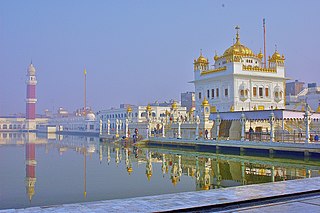
Tarn Taran Sahib is a city in the Majha region of the state of Punjab, in northern India. It is the district headquarters and hosts the municipal council of Tarn Taran district. Gurdwara Sri Tarn Taran Sahib, a prominent Sikh shrine, is located in the central part of the city.

Chamkaur Sahib is a Sub Divisional town in the district of Rupnagar in the Indian State of Punjab.
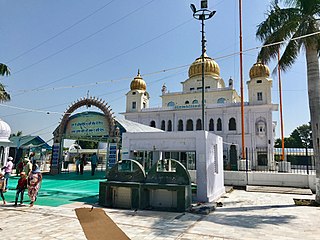
Fatehgarh Sahib is a city and a sacred pilgrimage site of Sikhism in the north west Indian state of Punjab. It is the headquarters of Fatehgarh Sahib district, located about 5 kilometres (3.1 mi) north of Sirhind. Fatehgarh Sahib is named after Fateh Singh, the 7-year-old son of Guru Gobind Singh, who was seized and buried alive, along with his 9-year-old brother Zoravar Singh, by the Mughals under the orders of governor Wazir Khan during the ongoing Mughal-Sikh wars of the early 18th century. The town experienced major historical events after the martyrdom of the sons in 1705, with frequent changes of control between the Sikhs and Mughals.

Majha is a region located in the central parts of the historical Punjab region, presently split between the republics of Pakistan and India. It extends north from the right banks of the river Beas, and reaches as far north as left bank of the river Ravi, constituting upper half of the Bari Doab.

Shaheedi Sabha is a three-day annual religious congregation (get-together) organised every year in December at Gurdwara Fatehgarh Sahib, in the Fatehgarh Sahib district of Punjab, India to pay homage to the martyrdom of Chhotte Sahibzade Baba Zorawar Singh and Baba Fateh Singh, the youngest sons of the 10th sikh guru Guru Gobind Singh.

The Saka Sirhindor the Nikke Sahibzada Saka refers to the martyrdom (Shaheedi) of the two sons of Guru Gobind Singh, named Zorawar Singh and Fateh Singh. The two Sikh children are remembered as the Nikke Sahibzade. They are believed to have attained martyrdom on 26 December 1704 at the ages of 5(or 6) and 9 respectively. In remembrance of this occasion, the Shaheedi Jor Mela is organised annually at Fatehgarh Sahib Punjab, India, to commemorate the supreme sacrifice at the place of their martyrdom on the 24th to 26th December.
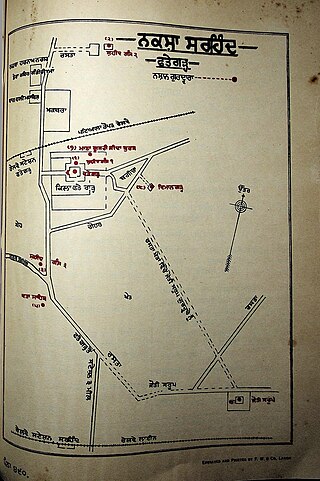
Sirhind is the older name of Fatehgarh Sahib, a city and Sikh pilgrimage site in Punjab, India. It is situated on the Delhi to Lahore Highway. It has a population of about 60,851 . It is now a district headquarters in the state of Punjab; the name of the district is Fatehgarh Sahib.
Kotla Suleman is a small village in Sirhind, Fatehgarh Sahib district, Punjab, India. It is located 2 kilometres to the south of the district headquarters, Fatehgarh Sahib, and 45 kilometres from the state capital, Chandigarh.
Baba Banda Singh Bahadur Polytechnic College (BBSBPC), Fatehgarh Sahib, Punjab, India was established in 2006 by the Baba Banda Singh Bahadur Educational Trust formed under the patronage of Shiromani Gurdwara Parbandhak Committee with the approval of the Government of Punjab.

The Haveli Todar Mal popularly known as Jahaz Haveli or Jahaz Mahal is the 17th century residence (haveli) of Todar Mal, who became the diwan in the court of Nawab Wazir Khan, the Governor of Sirhind, under Mughal Empire. Today, it is remembered for the cremation of young martyred sons of Guru Gobind Singh and his mother.

Aam Khas Bagh is the remains of a highway-inn constructed for the use of royalty as well as common people. It was divided into two parts - the Aam for public use and the Khas for private use by the Royalty. This Royal inn was initially built by Akbar and planned by Mughal architect Hafiz Rakhna. It was rebuilt by Mughal Emperor Shah Jahan along the Mughal military road between Delhi and Lahore. The Royal couple used to stay here in the old building complex while going to and coming back from Lahore. Later on, some additions were made to this monument by Mughal Emperor Jahangir.
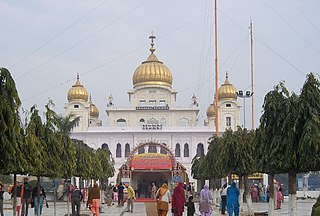
Gurdwara Fatehgarh Sahib is a Sikh gurdwara or place of worship in the city of Fatehgarh Sahib in the Indian state of Punjab. The gurdwara marks the 1710 conquest of the city by the Sikhs under the leadership of Banda Singh Bahadur. Sikhs captured the area and razed the fort built by Ferozshah Tughlaq to the ground.
Baba Moti Ram Mehra was a devoted disciple of Guru Gobind Singh who, disregarding the risk to his own life, managed to enter the Thanda Burj in a very dramatic manner and serve milk to Mata Gujri, Baba Zorawar Singh and Baba Fateh Singh, the two younger Sahibzadas (sons) of Guru Gobind Singh for three nights, where they were kept under arrest by the Mughal Governor of Sirhind, Wazir Khan.

Rauza Sharif is a shrine (Dargah) in the Punjab state of India dedicated to the Sufi teacher Shaikh Ahmad al-Faruqī al-Sirhindī . It is located to the north of Gurdwara Fatehgarh Sahib and is where Sirhindi lived during the reigns of Mughal Emperors Akbar and Jahangir.
Jasrat Khokhar was a 15th-century Punjabi Muslim ruler of Sialkot from 1410 until his death in 1442.
































